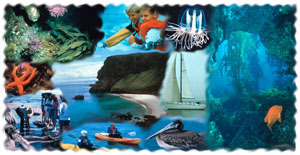|
|
Error processing SSI file |
|
|
|
|
The distribution of plants and animals in the Sanctuary is strongly influenced by the unique combination of warm and cold-water currents that surround the islands. More than 1000 species of aquatic plants, fish, invertebrates, marine mammals and marine birds are found within the protected waters of the Channel Islands National Marine Sanctuary and new species are continually being discovered. The Sanctuary also provides full or part-time homes for several threatened and endangered species including blue, humpback and sei whales, southern sea otters, the California brown pelican and the California least tern.
The Sanctuary also supports valuable commercial industries such as fishing, diving, boating and tourism. In 1999, a community based Sanctuary Advisory Council was created to advise and assist the Sanctuary Manager on developing policies related to protecting the resources within the boundaries of the Sanctuary. The Sanctuary Advisory Council is represented by ten members from local, state and federal government agencies and ten community members representing tourism, recreation, fishing, business, research, conservation, education and general public interests.
The photo gallery contains images which portray only a small portion of the living and physical resources of the sanctuary. In addition, it portrays some of the major uses of the sanctuary. For a more detailed description of the marvels of Channel Islands National Marine Sanctuary visit the Channel Islands description on the Marine Sanctuaries section of this site.
The
Collection
The Living Sanctuary presents 18 photos depicting marine mammals, fish, birds, and invertebrates. Among these images are sea lions, blue sharks, dolphin, starfish, treefish, murrelets, jellyfish, bryzoans, and giant kelp to name just a few.
Habitats presents 16 photos depicting the various marine and nearshore habitats making up the sanctuary. Included in this section you will find satellite images of sea surface temperatures, photos of each of the large islands, and species which take advantage of the various physical habitats found in the Channel Islands National Marine Sanctuary.
People and the Sanctuary presents 13 images depicting the many ways that human beings use the sanctuary and its adjacent areas. You will see people recreating, researching, working, and learning the important lessons that the sanctuary has to offer.
The Sustainable Seas Expeditions photos for the May - June 1999 expedition to the Channel Islands National Marine Sanctuary are not available.
The Kids Gallery for the Channel Islands National Marine Sanctuary has no entries at this time.

